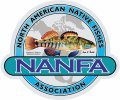Captive Care Notes: Spotfin Chub (Erimonax, Family Cyprinidae)
Spotfin Chub (Erimonax monachus) are cultured at Conservation Fisheries, Inc. (CFI) in Knoxville, Tennessee, as part of the minnow's recovery program. The fish are kept in 100-gallon aquariums and fed live blackworms, frozen bloodworms, frozen and live daphnia, and several prepared foods. Water temperatures are gradually increased from a winter low of 12C (54F) to 20-24C (68-75F) to simulate conditions in the wild. Photoperiod is likewise gradually increased from 10 hours to 15 hours per day (J. R. Shute, pers. comm.). Immediately before spawning the fish are offered more food and fed more frequently, 2-3 times per day.
Like satinfin shiners (Cyprinella), Spotfin Chub are "crevice spawners" that deposit their eggs in crevices in submerged logs, loose bark on fallen trees, tree roots, and other woody debris, or in the cracks between rocks and boulders. In captivity, the preferred spawning substrate is a stack of 8-15 15.3 x 15.3 x 0.5 cm (6 x 6 x 0.2 in) unglazed ceramic tiles. Spawning takes place between the flat rocks and in the crevices between the tiles. Males seem to select the spawning site, and appear to deposit milt prior to the arrival of the female. The spawning act itself lasts only a fraction of a second, with the male quickly swimming down beside the female and quivering briefly as they both press their vents against the crevice. Eggs are deposited far enough into the crevice to cover the undersurface of the ceramic tiles. Exposed eggs are quickly eaten by both sexes. Individual tiles with eggs are removed and placed into incubation trays suspended in 20-gallon aquariums. Eggs hatch six days later at 25C (77F). Larvae, which stay near the bottom, are fed brine shrimp nauplii. They grow quickly and begin to explore the middle water column at about 30 days of age.
